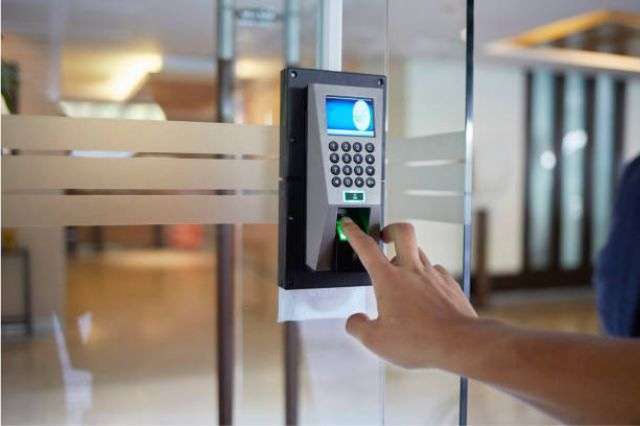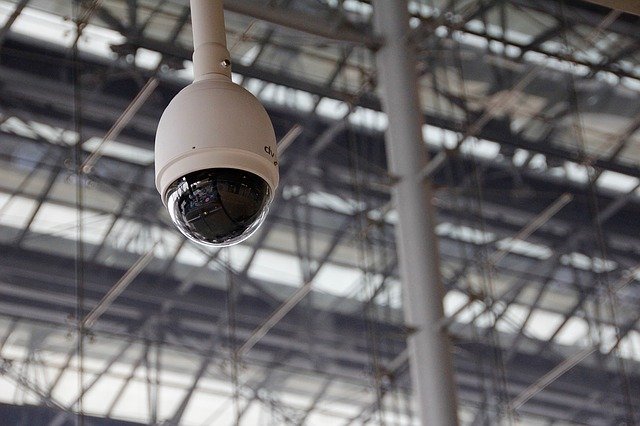Access Control Systems for Your Business: A Clear Choice
Access control systems have become increasingly popular in recent years as businesses seek to protect their assets and employees. These systems allow businesses to monitor and control access to their buildings, rooms, and sensitive areas. Access control systems come in a variety of forms, including key cards, biometric scanners, and PIN codes.
One of the main benefits of access control systems is the ability to restrict access to certain areas of a building. This can be especially important for businesses that deal with sensitive information or valuable assets. By limiting access to these areas, businesses can reduce the risk of theft or unauthorized access. Access control systems can also help businesses comply with regulations and standards related to security and data privacy.
Overall, access control systems can provide peace of mind for business owners and managers. By implementing these systems, businesses can better protect their assets, employees, and customers. However, it is important to carefully consider the specific needs and requirements of your business before investing in an access control system.
In this article, we will be discussing extensively the following;
- Why Your Business Needs Access Control Systems
- Types of Access Control Systems
- Choosing the Right Access Control System
- Implementing Access Control Systems
- Potential Challenges and Solutions
- Conclusion
Why Your Business Needs Access Control Systems
Access control systems are an essential part of any business’s security infrastructure. They offer a range of benefits that can help keep your employees, assets, and data safe. Here are some reasons why your business needs access control systems:
-
Protects Against Unauthorized Access
Access control systems ensure that only authorized personnel can enter certain areas of your business. This helps prevent theft, vandalism, and other unauthorized activities that can harm your business. With access control systems, you can restrict access to sensitive areas such as server rooms, data centers, and executive offices.
-
Provides a Record of Entry and Exit
Access control systems keep a record of who enters and exits your business premises. This can be useful in case of a security breach or other incidents. You can use this data to track employee attendance, monitor visitor traffic, and investigate security incidents.
-
Enhances Employee Safety
Access control systems can also enhance employee safety by preventing unauthorized individuals from entering the premises. This is especially important in high-risk industries such as healthcare, finance, and law enforcement. With access control systems, you can ensure that only authorized personnel can access hazardous areas such as chemical storage rooms, radiation labs, and crime scenes.
-
Improves Operational Efficiency
Access control systems can also improve operational efficiency by streamlining access to different areas of your business. With access control systems, you can grant access to specific areas based on an employee’s job function or level of clearance. This can help reduce the time and effort required to manage access to different areas of your business.
In conclusion, access control systems are an essential part of any business’s security infrastructure. They offer a range of benefits that can help keep your employees, assets, and data safe. By implementing access control systems, you can protect against unauthorized access, provide a record of entry and exit, enhance employee safety, and improve operational efficiency.
Types of Access Control Systems
Access control systems can be classified into four main types:
-
Discretionary Access Control (DAC)
Discretionary Access Control (DAC) is a type of access control system that allows the owner of the resource to decide who has access to it. The owner can grant or deny access to any user or group of users. This type of access control system is commonly used in small businesses where there are only a few users who need access to the resources.
-
Mandatory Access Control (MAC)
Mandatory Access Control (MAC) is a type of access control system that is used in organizations where security is of utmost importance. In this type of access control system, the owner of the resource does not have the authority to grant or deny access to any user. Access is determined by the system administrator based on the user’s security clearance level.
-
Role-Based Access Control (RBAC)
Role-Based Access Control (RBAC) is a type of access control system that is based on the user’s role in the organization. Users are assigned roles, and access is granted based on the user’s role. This type of access control system is commonly used in large organizations where there are many users who need access to the resources.
-
Rule-Based Access Control (RBAC)
Rule-Based Access Control (RBAC) is a type of access control system that is based on a set of rules defined by the system administrator. Access is granted or denied based on these rules. This type of access control system is commonly used in organizations where there are complex security policies that need to be enforced.
Each type of access control system has its advantages and disadvantages. It is important to choose the right type of access control system based on the organization’s security needs.
Choosing the Right Access Control System
When it comes to choosing the right access control system for your business, there are a few factors to consider. Here are some key points to keep in mind:
-
Identify Your Needs
Before you start looking at different access control systems, it’s important to identify your specific needs. What areas of your business do you want to restrict access to? How many employees will need access? Do you need to integrate your access control system with other security measures, such as CCTV or alarms?
-
Consider the Type of Access Control System
There are several different types of access control systems to choose from, including:
- Keycard systems
- Biometric systems
- Keypad systems
- Proximity systems
Each type of system has its own advantages and disadvantages, so it’s important to choose the one that best fits your needs.
-
Evaluate the Features
When comparing different access control systems, it’s important to evaluate the features of each one. Some features to look for include:
- Integration with other security measures
- Remote access and monitoring
- Customizable access levels
- Reporting and audit trails
-
Consider the Cost
Access control systems can vary widely in cost, so it’s important to consider your budget when choosing a system. Keep in mind that while a more expensive system may have more features, it may not necessarily be the best fit for your business.
By considering these factors when choosing an access control system, you can ensure that you select the right one for your business’s specific needs.
Implementing Access Control Systems
Implementing access control systems is a crucial step towards securing your business premises. It involves setting up a system that only allows authorized personnel to access specific areas or data within your organization. The following are some key considerations when implementing access control systems:
Identify Access Control Needs
Before implementing an access control system, it is essential to identify the specific needs of your business. This involves identifying the areas or data that require restricted access and the level of security required. For instance, if you run a healthcare facility, you may need to restrict access to patient records to only authorized personnel.
Choose the Right Access Control System
There are various types of access control systems, including biometric, proximity, and keypads. Each system has its strengths and weaknesses, and the choice of system will depend on the specific needs of your business. For instance, biometric systems are more secure than keypad systems, but they may be more expensive to install.
Implement Access Control Policies
Implementing access control policies involves setting up rules and procedures that govern the use of the access control system. For instance, you may need to set up rules regarding the issuance of access cards or the use of passwords. It is essential to ensure that all employees understand the policies and comply with them.
Regular Maintenance and Upgrades
Access control systems require regular maintenance and upgrades to ensure that they remain effective. This involves testing the system regularly to identify any vulnerabilities and addressing them promptly. It is also essential to keep the system up to date with the latest security patches and upgrades.
In conclusion, implementing access control systems is an essential step towards securing your business premises. It involves identifying the specific needs of your business, choosing the right access control system, implementing access control policies, and regular maintenance and upgrades. By following these steps, you can ensure that your business is secure from unauthorized access.
Potential Challenges and Solutions
Implementing an access control system in a business can bring several benefits, but it also comes with potential challenges that need to be addressed. This section will discuss some of the most common issues that businesses may face when implementing access control systems and offer possible solutions.
1. Integration with Existing Systems
One challenge that businesses may face when implementing access control systems is integrating them with existing systems. For example, if a business already has a security system in place, it may be difficult to integrate the new access control system with the existing one. This can result in additional costs and delays in implementation.
To address this challenge, businesses should carefully consider the compatibility of the access control system with their existing systems before making a purchase. They should also work closely with the vendor to ensure that the installation and integration process goes smoothly.
2. Employee Resistance
Another challenge that businesses may face is employee resistance to the new system. Employees may feel that the new system is intrusive and may be resistant to using it. This can result in low adoption rates and may even lead to employee turnover.
To overcome this challenge, businesses should involve employees in the decision-making process and provide training and support to ensure that they are comfortable using the new system. It is also important to communicate the benefits of the new system to employees to help them understand why it is necessary.
3. Cost
The cost of implementing an access control system can also be a challenge for businesses. The initial investment can be significant, and ongoing maintenance and support can add to the cost over time.
To address this challenge, businesses should carefully consider their budget and choose a system that meets their needs without exceeding their financial capabilities. They should also consider the long-term benefits of the system and how it can help them save money in the long run.
Overall, while implementing an access control system can come with challenges, there are solutions available to address them. By carefully considering the compatibility of the system with existing systems, involving employees in the decision-making process, and carefully managing costs, businesses can successfully implement an access control system and enjoy the benefits it brings.
Conclusion
Access control systems can provide significant benefits to businesses of all sizes. They offer a range of features and capabilities that can help improve security, increase efficiency, and reduce costs. However, whether or not to invest in an access control system depends on a variety of factors, including the size of the business, the nature of its operations, and its budget.
For businesses that have a large number of employees, customers, or visitors, access control systems can be an effective way to manage access and ensure that only authorized individuals are able to enter certain areas. They can also help prevent theft, vandalism, and other types of crime by providing a record of who has entered and left a particular area.
Access control systems can also help businesses improve efficiency by automating certain tasks, such as unlocking doors or gates at specific times of day. This can help reduce the workload of security personnel and allow them to focus on other important tasks.
However, access control systems can be expensive to install and maintain, and they may not be necessary for every business. Small businesses with few employees and a limited budget may be better off using traditional lock and key systems.
In conclusion, access control systems can be a valuable investment for businesses that require a high level of security and efficiency. However, businesses should carefully consider their needs and budget before deciding whether or not to invest in such a system.









